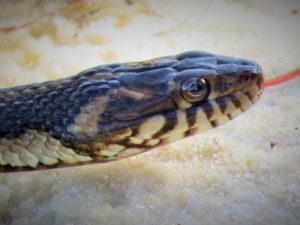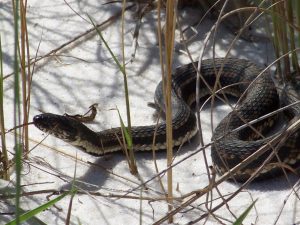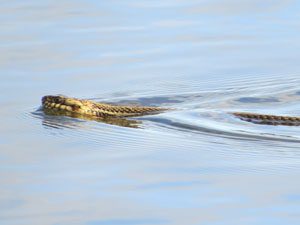I am writing about this animal because, though it is rare to see them, our terrapin volunteers saw two this past week; and maybe you will too.

The round pupil and vertical jaw stripes indicate this is the nonvenomous Nerodia. Photo: Carole Tebay
The Gulf salt marsh snake is one of those, like the eastern coral snake, that is actually common – just rare to see. It is rare to see because (a) it lives in muddy salt marshes, where we rarely venture, and (b) it is mostly nocturnal – and even fewer of us venture into muddy salt marshes at night.
It is in the genus Nerodia, which includes the common water snakes like the banded water snake (Nerodia fasicata). It is a harmless nonvenomous snake. However, because of where it lives, it is often confused with a cottonmouth and is killed. A common name for this snake in Alabama is “bay moccasin”.
Their name is Nerodia clarkii, but it is a subspecies of this group – so the actual name is Nerodia clarkii clarkii. The other two subspecies are found in Florida. The Mangrove salt marsh snake (Nerodia clarkii compressicauda) is found from central Gulf coast of Florida, around the Keys to Indian River County on the Atlantic coast. The Atlantic salt marsh snake (Nerodia clarkii taeniata) has a very small range. Originally reported in Volusia, Brevard, and Indian River counties – due to the northern expansion of mangroves, it is believed to only be in Volusia County now. It is listed as THREATENED both federally and with the state. Our Gulf salt marsh snake is found from central Florida to Texas.
It is a relatively small snake, only reaching a length of around 15-20 inches, though some have been reported at 30 inches. They possess two long yellowish-tan stripes running laterally the length of its body, the only species of Nerodia to do so. Again, they move at night feeding on small crabs, shrimp, frogs, and small fish. During daylight hours they hide beneath the wrack or other vegetation avoiding herons, egrets, and larger blue crabs. Lacking the needed glands, they cannot desalinate seawater the way sea turtles and terrapins can. All of their freshwater comes from their food and from rainfall.
They breed in the spring, possibly why we are seeing them now, and give live birth to about 10 young in midsummer. They are of moderate conservation concern in Alabama due to the loss of salt marsh. The loss of salt marsh habitat and rise of sea level are their major concerns at this point.
I do need to warn you, though it is a small, nonvenomous snake, they will bite. If bitten, soap and water will do the job. For me, and others, it is actually exciting to see them because of their reclusive nature. If you see one while exploring our intracoastal waters, know that you are not in any danger but rather lucky to see this “mystery of the marsh”.
References
Gulf Salt Marsh Snake – Texas Parks and Recreation – https://tpwd.texas.gov/huntwild/wild/species/gulfsnake/.
iNaturalist – https://www.inaturalist.org/guide_taxa/776612.
Outdoor Alabama – Alabama Department of Conservation and Natural Resources – https://www.outdooralabama.com/non-venomous-snakes/gulf-saltmarsh-snake.
Atlantic Salt Marsh Snake – N.c.taeniata – U.S. Fish and Wildlife – https://www.fws.gov/northflorida/Species-Accounts/Atl-Salt-Marsh-Snake-2005.htm.
- St. Joe Red Tide Claiming Terrapins - December 15, 2025
- The 2025 Snake Watch Report for the Pensacola Bay Area - December 15, 2025
- Rattlesnakes on Our Barrier Islands; Part 2 – Prey Selection - December 15, 2025


